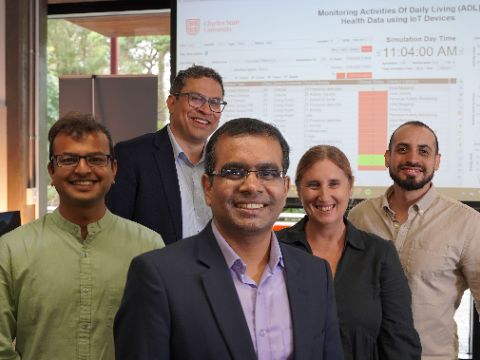- A Charles Sturt University project usingsensor technology and predictive analyticscouldrevolutionise aged care services in Australia and globally
- The project is not just a technological innovation but a new model in aged care offering a proactive approach to the well-being and dignity of the ageing population
- By harnessing the power of technological solutions, the project allows for smarter use of resources with care tailored more precisely to each person’s needs
A project team of Charles Sturt University health and computer science specialists aims to revolutionise aged care in Australia and globally.
The project, ‘Investigating non-intrusive technology for real-time anomaly detection in elderly behavioural patterns’, uses sensor technology and predictive analytics for early detection of anomalies in activities of daily living for older adults.
Whether people choose to age in the same place and remain within their homes or move into an aged care setting, the program can provide peace of mind for individuals and their carer’s allowing for early alerts and care in the instance of health challenges such as falls.
 The multidisciplinary project team (pictured left) is led by Lecturer in Computing Dr Gea Rahman (picture inset above) in the Charles Sturt School of Computing, Mathematics and Engineering, and supported by co-investigators Senior Lecturer in Computing Dr Sabih Rehman, and Lecturer in Nursing and Midwifery Dr Shanna Fealy in the Charles Sturt School of Nursing, Paramedicine and Healthcare Sciences.
The multidisciplinary project team (pictured left) is led by Lecturer in Computing Dr Gea Rahman (picture inset above) in the Charles Sturt School of Computing, Mathematics and Engineering, and supported by co-investigators Senior Lecturer in Computing Dr Sabih Rehman, and Lecturer in Nursing and Midwifery Dr Shanna Fealy in the Charles Sturt School of Nursing, Paramedicine and Healthcare Sciences.
They are supporting co-research associates Mr Sebastian Ramirez and Mr Aayush Fuskaley to advance their skills in this area of health and computer science.
Dr Rahman said the team is dedicated to finding innovative solutions that blend empathy and safety with cutting-edge technology as Australia braces for a significant demographic shift over the next 40 years with population ageing presenting an escalating challenge.
“One in every six Australians is currently aged over 65 years and this population demographic is set to double with the number of centenarians projected to increase six-fold,” Dr Rahman said.
“So, we are facing pressing issues with the provision of aged care services, with an escalating need for innovative strategies to ensure older Australians ‘age well’.
“This project aims to leverage technology to address these challenges, reducing the emotional and financial burdens on individuals and the government, and influencing policy changes.”
Dr Rahman, whose expertise is in data science, intends that the project will have a positive impact.
“Our project is not just a technological innovation; it’s a new paradigm in aged care, offering a proactive approach to ensure the well-being and dignity of our aging population,” he said.
The key elements of the project are:
- Innovative technology: the team is implementing non-intrusive sensor technology in homes to monitor daily activities discreetly. By applying machine learning to the data collected, they can identify patterns and detect early signs of potential falls or other issues, addressing problems before they escalate.
- Community engagement: the project engages staff and student volunteers who simulate daily activities to refine and test our technology, ensuring its effectiveness in real-world settings.
- Unique features: unlike existing solutions that aren’t adaptable and often generate false alarms, this system learns and evolves with the user’s behaviour, reducing the risk of errors and enhancing reliability.
- Hardware innovation: the team has been at the forefront of developing the architecture to deploy the sensor technology for efficient data collection and processing, enabling real-time insights into individual behaviour.
- Software development: team members have been instrumental in designing adaptive machine learning models which are essential for the project to provide personalised and accurate assessments.
Dr Sabih Rehman emphasised the importance of technological solutions in addressing workforce challenges, including the pressing issue of care worker shortages.
“By 2050 it’s predicted that there will be a shortfall of 200,000 care workers,” Dr Rehman said.
“By harnessing the power of technological solutions, our project aims to lessen the need for constant checks on the elderly, allowing for smarter use of resources. This means care can be tailored more precisely to each person’s needs, boosting efficiency in the process.”
The project also offers the prospect of integration into healthcare.
Dr Shanna Fealy in the Charles Sturt School of Nursing, Paramedicine and Healthcare Sciences has played a key role in ensuring the project meets the practical real-world issues faced by the aged care industry and ensuring the project is conducted with high ethical standards.
Dr Fealy believes the project could lead to fewer hospital visits and more responsive care for older adults.
“There’s potential for it to be woven into everyday healthcare, particularly in less urban areas, thus helping the aged care industry and healthcare workers to make better decisions based on solid data,” Dr Fealy said.
“Our system’s ability to notice subtle changes, like shifts in someone’s daily routine, could give early warnings of potential health issues, enabling quicker and more appropriate responses from caregivers and emergency services.”
This project has been possible due to generous funding from the Charles Sturt Artificial Intelligence and Cyber Futures Centre (AICFI) and the support of the Charles Sturt School of Computing, Mathematics and Engineering allowing the use of its Network Engineering Lab at the University in Port Macquarie.






Social
Explore the world of social